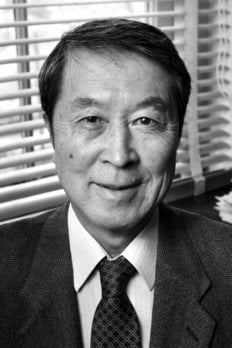Yoichiro Nambu
Biographical

I was born in 1921 in Tokyo and grew up in the provincial city of Fukui. I studied physics at the Imperial University of Tokyo from 1940 to 1942, graduating at the level of M.S. Then I was drafted into an army radar laboratory. After the end of the war, in 1946, I returned to the University of Tokyo as a kind of research associate. I received a doctorate in 1952. In 1950 I became professor at a newly created Osaka City University, a position I held until 1956. But from 1952 to 1954 I stayed at the Institute for Advanced Study in Princeton, USA, as a member, and from 1954 to 1956 at the University of Chicago as a research associate. I was made associate professor at Chicago in 1956, professor in 1958, and Distinguished Service Professor in 1971. From 1973 to 1976 I served as chairman of the department of physics. In 1976 I became Henry Judson Distinguished Professor, from which position I retired in 1991 and became Emeritus.
I married Chieko Hida in 1945 and have a son, Jun-ichi. I have been a citizen of the United States of America since 1970. I hold honorary degrees from Osaka City University (1980), Northwestern University (1985), and Osaka University (1997). I have been a member of the United States National Academy of Sciences and the American Academy of Arts and Sciences since 1971, and an honorary member of the Japan Academy since 1984.
A partial list of the prizes I received in the past is:
• Dannie Heineman Prize, American Physical Society (1970)
• Order of Culture, Government of Japan (1978)
• United States National Medal of Science (1982)
• Max Planck Medal, German Physical Society (1985)
• Dirac Medal, International Centre for Theoretical Physics, Trieste (1986)
• Sakurai Prize, American Physical Society (1994)
• Wolf Prize, Government of Israel (1995)
• Gian Carlo Wick Medal, World Federation of Scientists, Lausanne (1996)
• Bogoliubov Prize, Joint Institute for Nuclear Research, Dubna (2003)
• Benjamin Franklin Medal, Franklin Inst., Philadelphia (2005)
• Pomeranchuk Prize, Inst. Theoret. and Exper. Physics, Moscow (2007)
My interests in physics have been mainly on the theoretical side. The University of Tokyo was good in condensed matter physics, but I was more attracted to nuclear and particle physics where names like Nishina, Tomonaga, and Yukawa in other institutions were making great contributions. As a student I was exposed to cosmic ray and particle physics by attending seminars held by Nishina and Tomonaga at their laboratory nearby. I started my research career at the time when Tomonaga was developing his theory of renormalization, for which he would receive the Nobel Prize. I was able to approach his group and start working on his theory and other topics in particle physics. At his recommendation I obtained the position at Osaka City University and later was invited to the Institute for Advanced Study. I owe my move to Chicago to M. L. Goldberger.
My work on spontaneous symmetry breaking (SSB), for which I am receiving the Nobel Prize, started around 1959. It is a result of my experience in both condensed matter and particle physics. The BCS theory of superconductivity in 1957 led me to the idea of SSB as a general phenomenon in physics. My work on its specific application to particle physics as a mechanism for generation of the nucleon mass and the pion was first published in 1960. Since then I have pursued the subject in various areas.
This autobiography/biography was written at the time of the award and later published in the book series Les Prix Nobel/ Nobel Lectures/The Nobel Prizes. The information is sometimes updated with an addendum submitted by the Laureate.
Yoichiro Nambu died on 5 July 2015.
Nobel Prizes and laureates
Six prizes were awarded for achievements that have conferred the greatest benefit to humankind. The 12 laureates' work and discoveries range from proteins' structures and machine learning to fighting for a world free of nuclear weapons.
See them all presented here.
